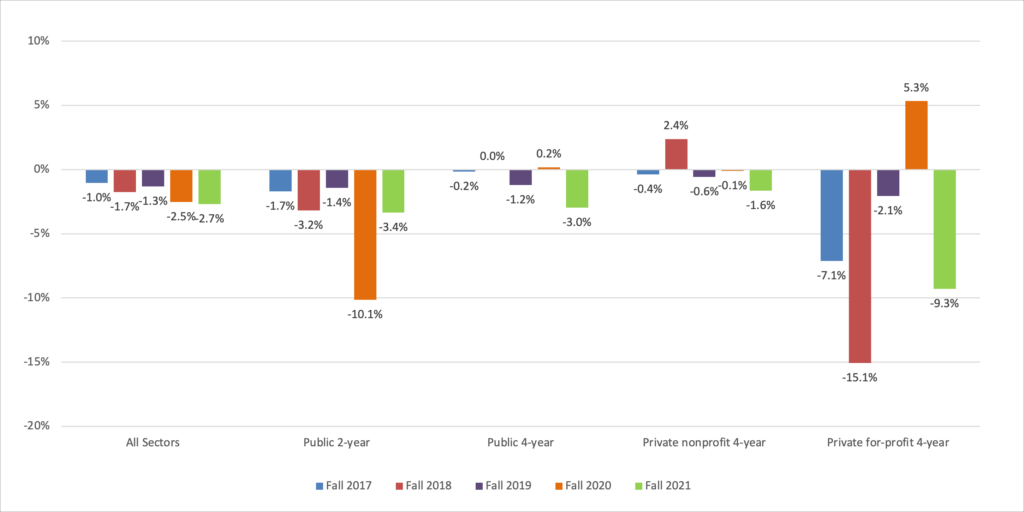Nationally, College Enrollment Continues Decline
Nationally, undergraduate enrollment fell by 3.1%, or 465,300 students last year, with public, four-year institutions losing the largest number of students (251,400 or -3.8%) compared to the previous year, reports the National Student Clearinghouse Research Center. Continued enrollment losses during the pandemic represent a total two-year decline of 5.1% or 938,000 students since fall 2019, the NSC Research Center reports.
Enrollment declines at community colleges were less severe in the fall of 2021 (-3.4% or 161,800 students) than in 2020. But over a two-year period, public two-year colleges remained the hardest hit sector since the start of the pandemic; enrollment plunged by 706,106 students, or -13.2% over 2019, the NSC reports.
Undergraduate enrollment declined across all institution sectors, with private, for-profit four-year colleges suffering the steepest percentage drop (-11.1% or 65,500 students). Private, nonprofit four-year undergraduate enrollment decreased by 2.2% or 58,700 students in the fall of 2021, the NSC reports. Public institutions (two-year and four-year combined), which enroll three out of every four undergraduates, showed a 3.1% decline, or nearly 398,600 fewer students.

Enrollment for first-year students slipped again, by 2.7% from fall 2020 to fall 2021 and 13.1% since 2019 at all institutions, except for private, nonprofit four-year institutions, the NSC reported.
Shrinking college enrollment has been linked to low unemployment levels, dissatisfaction with rising college costs, public skepticism and declining birthrates. Whatever the reason, the United States is “experiencing a higher education enrollment crisis,” San Jose Spotlight says.
In January, Jon Marcus, editor of The Hechinger Report, a national nonprofit newsroom which covers education, wrote a piece exploring what the decline in college enrollment means for the country, called, Another million adults ‘have stepped off the path to the middle class.’
“People without education past high school earn significantly less than classmates who go on to earn bachelor’s degrees and are more likely to live in poverty and less likely to be employed. They’re more prone to depression, live shorter lives, need more government assistance, pay less in taxes, divorce more frequently and vote and volunteer less often,” Marcus wrote.
The Lumina Foundation presented a webinar in early April: Our Nation’s Enrollment Plunge; Reversing the Trend, with representatives from higher ed, industry, the National Student Clearinghouse, the U.S. Department of education and journalists, including Marcus. The drop in post-secondary education has not only life-long implications for a generation, but for the industries in need of an educated workforce, participants said.
Historically, the longer students are away from college, the less likely they are to return as work and family commitments crowd out education. This phenomenon instills an urgency in the work of Achieve Hartford and the ALL IN! Coalition partners.

